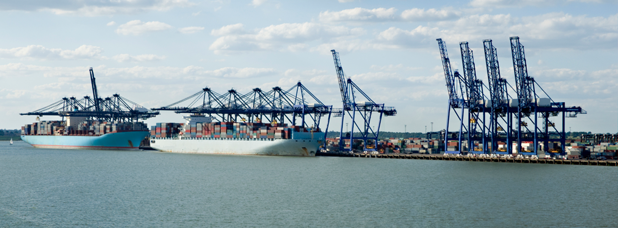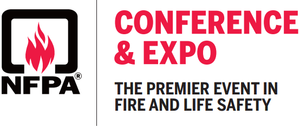Case study: Port of Felixstowe
- Tsunami Early Warning System in Philippines
- Flood alert sirens for Chesil Beach with the Environment Agency
- Case Study: Concept Systems use E2S's unique Appello sounders to improve safety at sea
- Case Study: Wembley Stadium Construction Site Warning System
- Tsunami Evacuation Alert System: City of Penco, Chile
- Network Rail: Appello alarm horn sounders assist with level crossing safety
- Port of Felixstowe: upgrading audible signals with the E2S Hootronic range

Introduction
The Port of Felixstowe is Britain’s biggest and busiest container port, and one of the largest in Europe. Handling more than 3.4million TEUs (Twenty-foot Equivalent Units) and welcoming over 4,000 ships a year the port is the best location in Britain for importing and exporting goods. Around 33 shipping lines operate from Felixstowe, offering approximately 90 services to and from 365 ports around the world.
Trinity Terminal is the largest container handling facility in the UK, and has one of Europe’s longest continuous quays, at 2,354 metres. The terminal has seven deep-water berths, varying in depth from 11.6 metres to 15 metres alongside, and some of the world’s largest container cranes. In addition, berths 8&9 are the only terminal in the UK that can handle the world’s latest Mega Vessels. The crane operations within the berths include 27 quayside cranes, 74 stacking cranes, 7 quayside ship-to-shore cranes and 22 stacking cranes.
Electro-Mechanical Alarms
For the safe operation of the cranes traditional electro-mechanical signalling devices had previously been used to warn personnel of the crane movement and proximity. However concerns over the reliability and performance plus the maintenance and running costs of the existing signals were a factor in initiating a search for replacement devices.
E2S assisted the Port of Felixstowe during their consultation process and offered the Hootronic range as a possible solution. The Hootronic range consists of a variety of products all of which use innovative digital storage technology enabling high definition recordings of electro-mechanical signals to be replicated exactly. The class D amplification circuit results in extremely high sound pressure levels making them effective over large distances.
This ability to replicate the types of sounds already in use at the port was a decisive factor as this minimised the necessity to retrain personnel and revise procedures.
After site testing the device chosen, and successfully implemented, at the port was the HMA121 Hootronic. The flame retardant impact resistant ABS enclosure offered a lightweight alternative whilst the stainless steel mounting bracket and ingress protection of IP66/67 ensured the installation was robust and more than capable of surviving the coastal environment. With a peak sound output of 124dB(A) at 1 metre it was not necessary to compromise on the effectiveness of the audible signal.
As a completely electronic product, continuously rated, and with no moving mechanical parts the HMA121 Hootronic resolved the concerns and issues of the Ports maintenance staff.
The Hootronic range devices contain five warning sounds: claxon, medium frequency siren, high frequency siren, buzzer and bell. Each of these sounds has two additional, remotely selectable, alarm stages. A remote switch option generates the genuine ‘tail off’ to a sound when the alarm is terminated.
For more information about the Hootronic range of products, please follow the links below:
- HA105N Electronic Siren, Buzzer, Claxon & Bell
- HA121 Electronic Siren, Buzzer, Claxon & Bell
- HMA121 Electronic Siren, Buzzer, Claxon & Bell
- HAL121X Electronic Siren, Buzzer, Claxon & Bell with Xenon Beacon
- HAL121H Electronic Siren, Buzzer, Claxon & Bell with LED Beacon
- HAB105RTH Electronic Siren, Buzzer, Claxon & Bell with Rotating Halogen Beacon
- HAB121RTH Electronic Siren, Buzzer, Claxon & Bell with Rotating Halogen Beacon
- HMCA112-05 Electronic Siren, Buzzer, Claxon & Bell with Xenon Beacon




.png)
